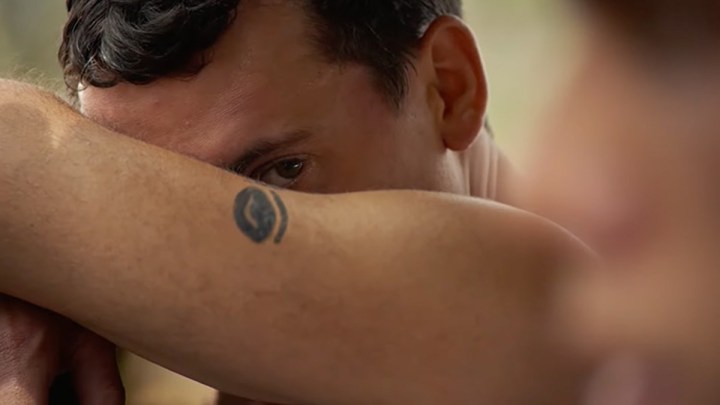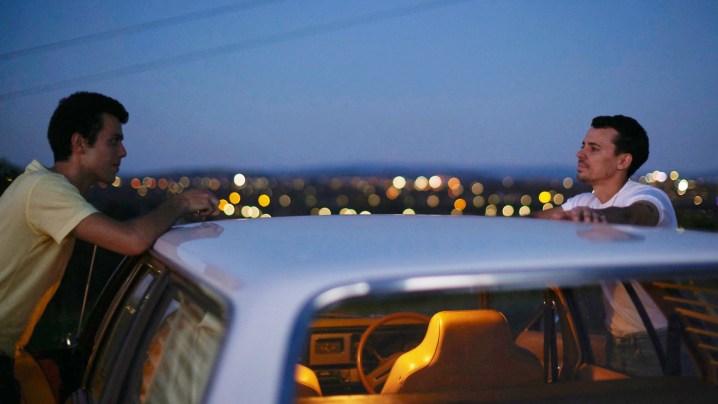It’s difficult to portray a coming-of-age story that’s both realistic and romantic. That’s what makes Goran Stolevski’s new movie, Of an Age, so special. In telling the tale of a Serbian-born Australian ballroom dancer falling slowly in and out of laove with his partner’s brother, Stolevski straddles the line between wistful and melancholy, acknowledging the pain of first love and the regret of a romance undone by time.
In an interview with Digital Trends, Stolevski and lead actors Thom Green and Elias Anton discuss the challenges of portraying characters over two different time periods, what compelled them to make the movie, and what viewers can take away from Of an Age after they’ve watched it.
Note: This interview has been edited for length and clarity.

Digital Trends: Your previous film, You Won’t Be Alone, is wildly different from this Of an Age. What made you decide to tell this story now?
Goran Stolevski: I mean, it’s never really intentional I do one film at this point, and then another film after that. I’m always stunned whenever I have the permission to make a movie. It took a long time to get to make this one.
I honestly didn’t know if anyone would be interested in this story, which is very specific to how I grew up. I wrote it so that it could connect to other people, but I just wasn’t sure if it did that. A couple of people I trust read the script and it made them cry. And they were very different from me. And then I was like, “OK, this could work.”
How long did it take to shoot?
Stolevski: It was around three-and-a-half weeks. We got a couple of days off in the middle so Thom and Elias can grow some facial hair for the second part, which takes place 11 years later.
Elias and Thom, what attracted you both to this film?
Elias Anton (Nikola/Kol): Well, when I first auditioned for it, I wasn’t given the full script. I was just given a few scenes that I was requested to tape for, so I was left to fill in a few of the blanks. After meeting Goran and Tom and having read the full script, I felt it was really impactful and it was something I definitely wanted to be a part of.
Thom Green (Adam): Yeah, a huge draw for me besides the script was Goran’s statement of intent, where he sort of went into great detail about a lot of the backstory to the film and why he wrote it.

Goran, why did you choose Elias and Tom for these roles?
Stolevski: It was a really complicated casting process, partly because initially with the script, as it was on the page, everyone, including me, assumed we would have to cast two separate actors to play the characters over two different time periods. Especially for Kol, I didn’t think it was physically plausible for anyone to portray someone who is 17 and then is 28, you know, not just physically, but also psychologically.
With Thom, I didn’t have that problem with his character. He was the best actor I came across for that role. He has a certain look, and a specific energy, that allowed for me, and the audience, to believe he could play Adam at both ages.
With Elias, he didn’t initially make the cut because he is exactly the opposite of how the character was written. Kol was supposed to be a short, skinny kid, and Elias is not that at all. But I was looking for the right feeling of the character more than anything else, and Elias had that.
Thom, your character, Adam, starts off as sort of the instigator in the first part and then, in the second part, becomes more submissive. How did you approach your characterization and the journey that your character takes in the film?
Green: I don’t know if he becomes entirely submissive. Without giving away too much away, there are certain things that he doesn’t disclose from the get-go. So there’s definitely a reason behind his reticence.
We did a lot of prep work with Goran for the 1999 section, which we shot first. We had a 3- to 4-day break in-between the two time periods, so both of our character’s transformations came naturally. For me, there wasn’t too much of a change internally because, in the first section of the film, he’s almost entirely grown into himself. He doesn’t change as much as Elias, who undergoes an incredible metamorphosis between the first part and the second part, which is set years later.

Elias, for your character, his transformation is almost the reverse of Thom’s; Kol is withdrawn and awkward in the first part, yet more extroverted and confident in the second part. How did you pull that off?
Anton: Well, there was a lot more vulnerability for younger Nikola because he is still closeted and unsure of his identity. With approaching the older Kol, it was more about just owning whom he has become and holding myself in a certain manner to suggest he had grown and accepted who he is.
A memorable moment in the film is the dance sequences with Kol at the beginning of the film and during the wedding toward the end of the film. Elias, how did you train for that?
Anton: I had a really good choreographer, Lauren Drago, who worked with me for about 30 hours of training. It was a lot more of a challenge to dance in the opening scene of the film because I have no partner to interact with; it’s just me dancing alone. I needed a lot more to make that dance scene work than the later one. [Laughs]
What do you want viewers to get out of Of an Age after they’ve watched it?
Green: I hope every person who watches it feels seen in some shape or form, whether it’s trying to find their own identity or whether they’ve already claimed it. And they feel like they’re championing it or celebrating it. That’s what I hope people take away from it.
Anton: Despite anyone’s identity, I think growing up, there’s always a sense of trying to discover for yourself who you are and your place in the world. I just hope that the audience is able to resonate with the characters in the story and find a bit of themselves in it.
Of an Age is currently playing in select theaters. It expands nationwide on February 17.
Editors' Recommendations
- Foe director Garth Davis on making the most devastating sci-fi movie ever
- 8 great movies by women directors you need to watch
- Swallowed cast and director on adding a new viewpoint to body horror films
- Director K. Asher Levin on genre filmmaking and his new horror movie, Slayers
- Speak No Evil director on making a horror movie about being too damn nice



